Experiments
The Palatibility of Tadpoles
In 1970, biologist Richard Wassersug conducted a study to determine what different kinds of tadpoles taste like. More specifically, whether some taste worse than others. He convinced 11 grad students to be his tadpole tasters.The most distasteful tadpole was Bufo marinus, while the most palatable ones were Smilisca sordida and Colostethus nubicola.
This confirmed his hypothesis that the most visible tadpoles were the least palatable. Their bad taste deterred predators from eating them, whereas the better tasting tadpoles relied on concealment to avoid being eaten.
Thirty years later, Wassersug was awarded an Ig Nobel Prize for this research.
More info: "On the Comparative Palatibility of Some Dry-Season Tadpoles from Costa Rica"
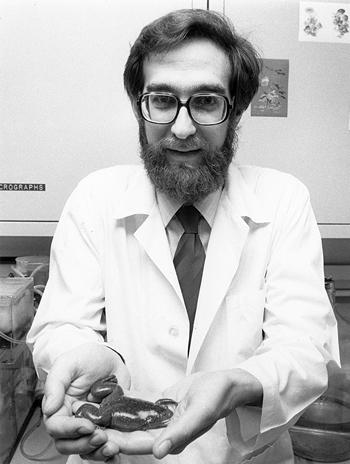
Richard Wassersug poses with a frog
image source: University of Chicago
Posted By: Alex - Thu Sep 29, 2022 -
Comments (2)
Category: Food, Science, Experiments
Bulletproof Ointment
1915: Inventor Percy Terry of Los Angeles believed that he had perfected an ointment that would toughen the skin so much that it would become bulletproof. He envisioned "an army of bulletproof men who could advance with immunity against anything less than cannon."He decided to test the ointment on himself. After rubbing it into his skin for several weeks, he shot himself in the face. Turned out, he wasn't bulletproof. He died at the County Hospital.
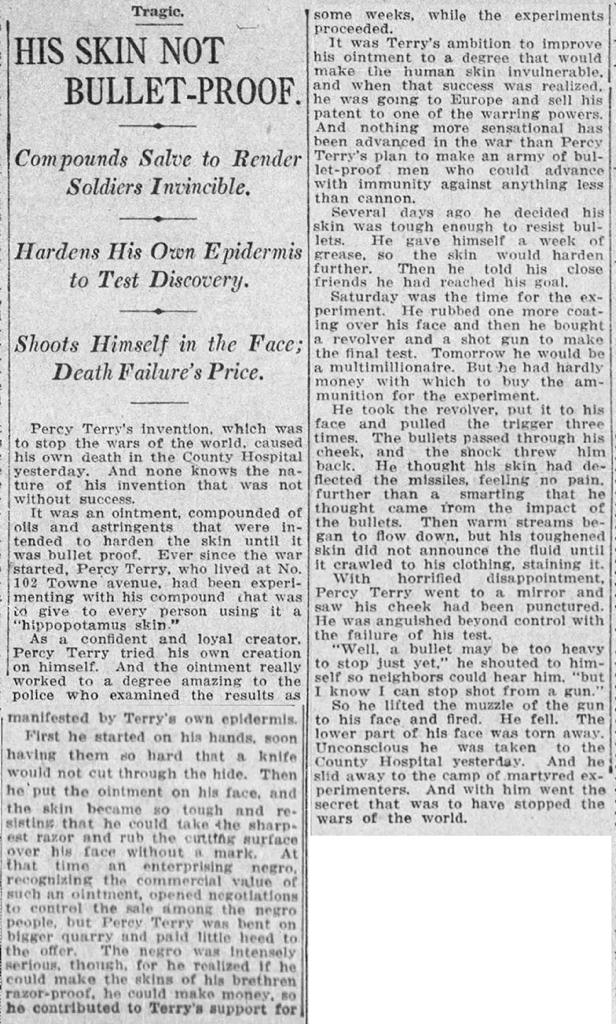
Los Angeles Times - Aug 30, 1915
Posted By: Alex - Sat Aug 20, 2022 -
Comments (5)
Category: Death, Experiments, 1910s, Weapons
Hydrox Fecalis
In order to advance medical knowledge, Dr. Stephen Sulkes and a handful of volunteers ate Hydrox cookies and later checked to see if their poop had turned black. It had. They named this phenomenon 'Hydrox Fecalis.' Their results were published in the New England Journal of Medicine (Jan 5, 1984). Reproduced below:The presence of dark stools can be a cause of consternation to the patient and is made more anxiety-producing when accompanied by abdominal pain or other discomfort. The causes of melena are well outlined in several reviews, along with the usual non-heme causes of black stools, including iron, bismuth, charcoal, licorice, and certain fruits.
To this list should be added the colorings present in chocolate sandwich cookies. In several independent tests (with myself and several volunteers as experimental subjects), the presence of black stools approximately 18 to 24 hours after ingestion of 225 to 450 g of chocolate sandwich cookies has been observed. Variation in brand of cookie did not change the stool character. Testing with other types of cookie (oatmeal, peanut butter, and chocolate chip, among others) has not resulted in the same stool findings, although abdominal pain or nausea or both appear to be equally frequent associations.
This phenomenon may be on the increase because of shifts in U.S. dietary habits, so elicitation of a good dietary history in cases of black stools and abdominal pain should be pursued. Inasmuch as "cookie-induced pseudomelena" is both unprofessional sounding and too appropriately descriptive, a suggested name for this entity is "Hydrox fecalis."
Stephen Sulkes, M.D.
Monroe Developmental Disabilities
Rochester, N.Y.
Someone needs to repeat the experiment with Oreo cookies.

Posted By: Alex - Tue Aug 16, 2022 -
Comments (1)
Category: Experiments, Junk Food, Excrement
The Pressed Frog Phenomenon
I found the image below at the Texas History site of the University of North Texas. It appears there as is, without any further explanation (or date).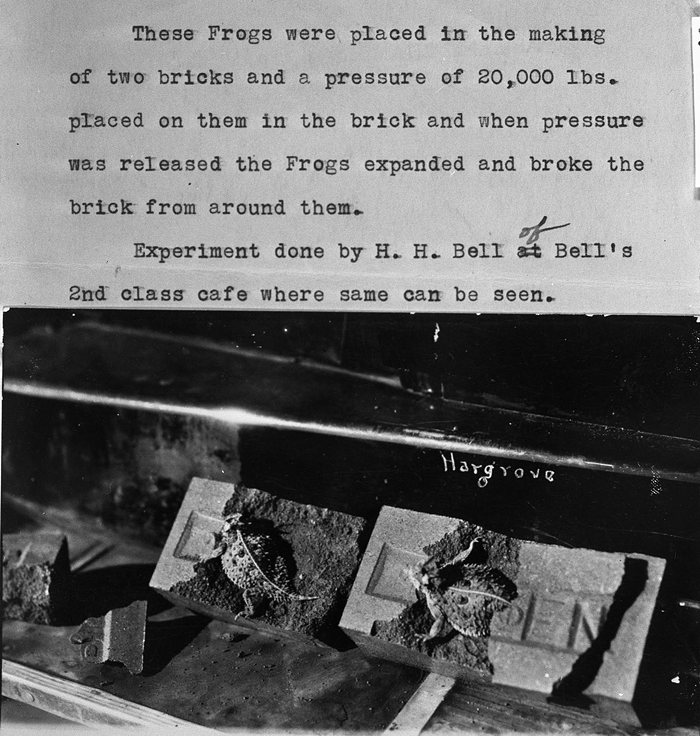
I realize that the indentations on top of bricks are called 'frogs', but why were actual frogs being placed inside bricks?
As far as I can tell, it must have been an experimental demonstration of the 'pressed frog phenomenon' — this phenomenon being that one can place a living frog inside a brick as its being made, apply thousands of pounds of pressure to the brick to mold it, and the frog will survive. The frog won't be happy about the experience, but it won't burst. Whereas the same pressure applied to a frog that isn't in a brick will definitely cause it to burst.
Obviously the brick hasn't been heated in a kiln, because that would definitely cook the frog.
The article below from 1925 explains the science of why a frog in a brick doesn't burst. The key part of the (overly long) explanation is this sentence:
However, this doesn't solve the mystery of who first decided to put a frog in a brick.
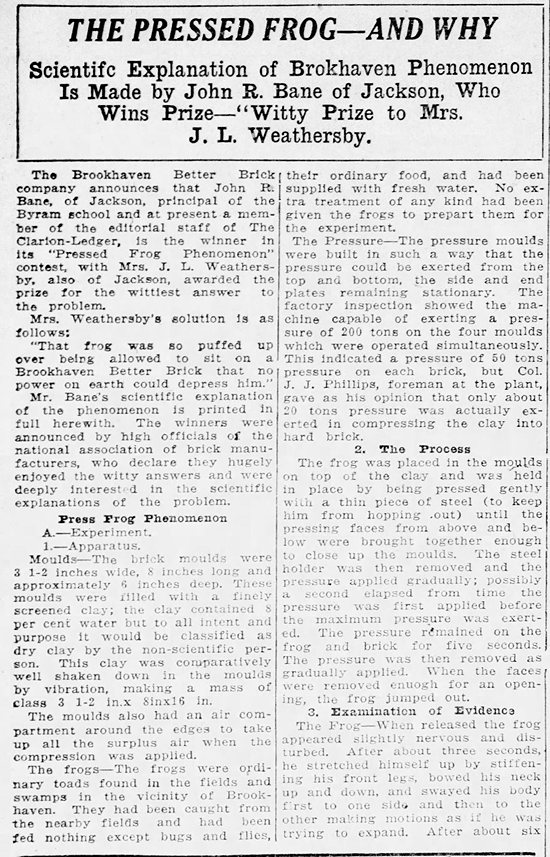

Clarion Ledger Sun - Aug 16, 1925
Posted By: Alex - Mon May 23, 2022 -
Comments (5)
Category: Animals, Science, Experiments, 1920s
Knives made from frozen human feces
The non-fiction book Shadows in the Sun by Wade Davis contains the following passage:This caught the attention of some archaeologists who decided to test if a knife made from human feces would actually be strong enough to cut through muscle and tendons. They published their results in the Journal of Archaeological Science.
The researchers paid close attention to detail. For instance:
However, the results were disappointing: "the knife-edge simply melted upon contact, leaving streaks of fecal matter."
Conclusion: the story of the fecal knife was an urban legend.
Posted By: Alex - Fri Mar 25, 2022 -
Comments (4)
Category: Science, Experiments, Excrement
The Case of the Furious Children
In 1954, six young boys who exhibited violent behavior were brought to live on the grounds of the National Institute of Health in Bethesda, Maryland. They were specifically selected because they were deemed the worst of the worst:For the next five years, the boys were attended around the clock by a team of specialists.
It was all part of an experiment, which came to be known as the "Case of the Furious Children," designed to find out why these young boys were so violent and whether they could be turned into responsible citizens. Eventually, around $1.5 million (in 1950's dollars) was spent on this effort.
By the end of the experiment, one of the researchers, Dr. Nicholas Long, said that the boys now had a "better than 50-50 chance of living a productive life." So what became of them? Were they reformed, or did they head down the path of crime and prison that they originally seemed to be destined for?
I'd be interesting to know, but I haven't been able to find anything out. I'm guessing the info has never been released because of privacy issues.
More info: Harpers Magazine - Jan 1958
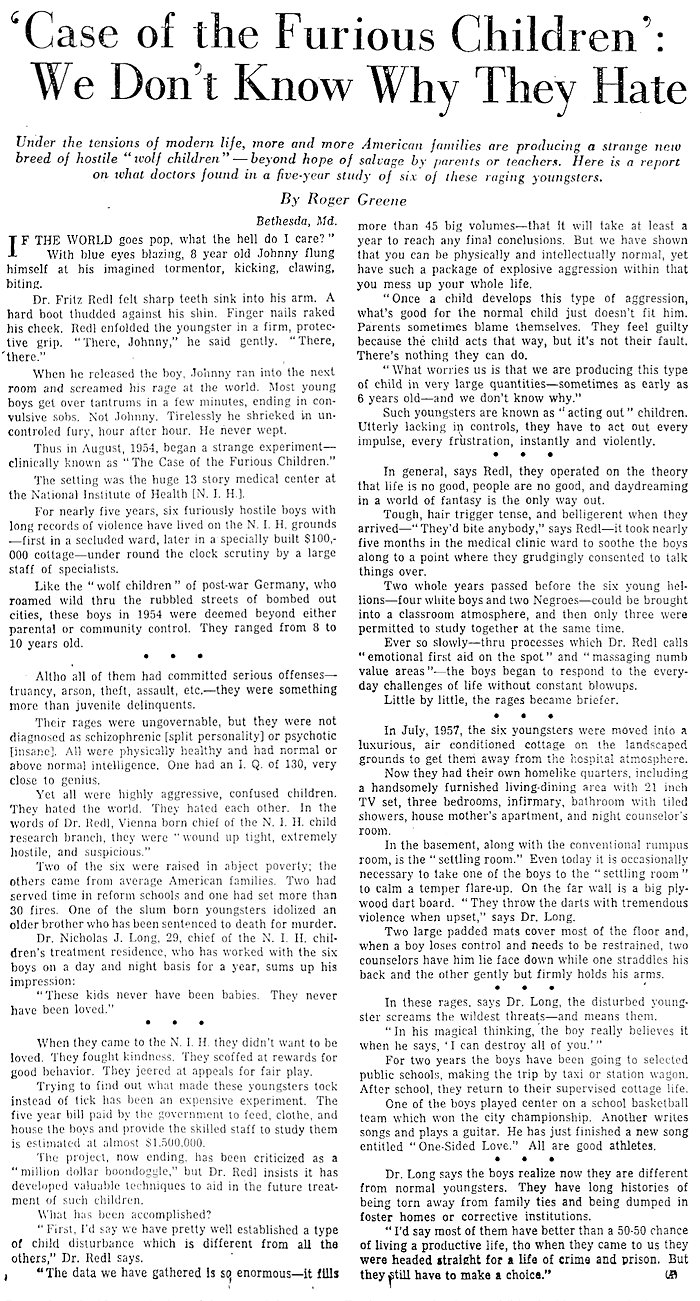
Chicago Daily Tribune - July 19, 1959
Posted By: Alex - Wed Jan 19, 2022 -
Comments (0)
Category: Antisocial Activities, Experiments, Psychology, Children, 1950s
Fish-Operated Vehicle
Scientists at Israel's Ben-Gurion University of the Negev trained goldfish to drive a "fish-operated vehicle" or FOV. Details from scmp.com:So how long before your Uber driver is a fish?
More info: "From fish out of water to new insights on navigation mechanisms in animals"
Posted By: Alex - Thu Jan 13, 2022 -
Comments (3)
Category: Motor Vehicles, Experiments, Fish
Hand-Sniffing After Handshakes
Research by biologists Noam Sobel and Idan Frumin reveals that after a handshake people frequently lift their hand to their nose and sniff it. The researchers hypothesize that this is to smell the body odor of the other person.As described by Sarah Everts in her recent book The Joy of Sweat:
"When we showed them the videos, many of the subjects were completely shocked and disbelieving," Frumin told me. "Some thought we had doctored the videos - not that we had the computing power or the expertise to do so."
. . . When Frumin now goes to conferences, he sometimes stands back and watches people unconsciously sniffing. "Sometimes I catch myself doing it too. People tell me I've ruined handshakes for them, that they've become very self-conscious about shaking hands, especially with me."
The Weizmann Institute has more info. Sobel and Frumin's article about their research is in the journal eLife Sciences.
Posted By: Alex - Wed Dec 08, 2021 -
Comments (6)
Category: Science, Experiments, Smells and Odors
Lambs in a wind tunnel
After spending more than $40,000 on the experiments the scientists concluded that lambs with short wool got cold faster than lambs with long wool.
Sounds like Nobel Prize material there.
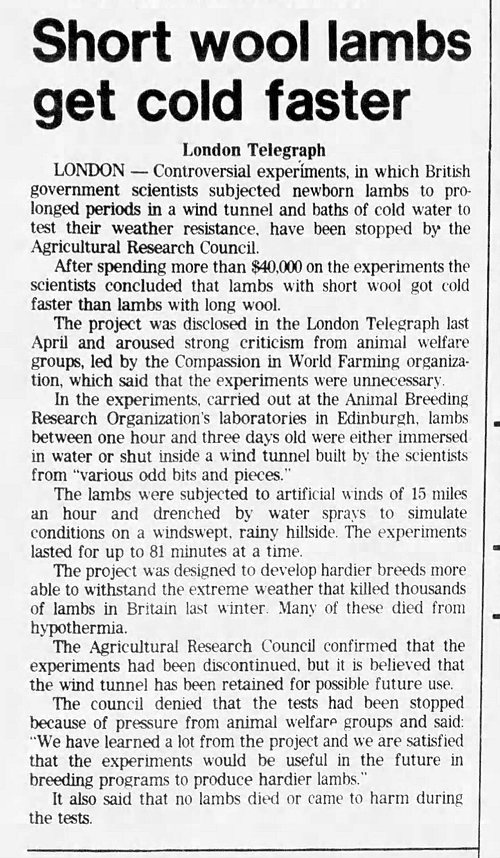
San Francisco Examiner - Dec 9, 1979
I'm not entirely sure, but Deborah Samson's research at the University of Edinburgh seems like it was the original study: "Genetic and physiological aspects of resistance to hypothermia in relation to neonatal lamb survival".
You can download at this link (pdf file) her doctoral thesis describing the research. As usual with things like this, the actual scientific study doesn't seem as wacky as the media report of it.
Update: While browsing through Samson's thesis, I discovered that she had a picture of the lamb "wind tunnel apparatus".

Posted By: Alex - Sun Dec 05, 2021 -
Comments (2)
Category: Experiments, Farming, 1970s
Jello Brainwaves
In 1974, Dr. Adrian Upton of McMaster University placed E.E.G. electrodes on a blob of lime jello and obtained positive readings. This indicated brain activity. He published his results in 1976 in the Medical Tribune.Upton was trying to demonstrate that when doctors use an E.E.G. to determine brain death, it can be difficult to obtain a perfectly flat readout, because the equipment picks up stray electrical activity from the surrounding environment. Or maybe he had discovered that jello is a sentient lifeform.
The Jell-O Gallery Museum in Le Roy, New York seems to prefer the latter conclusion. A brain-shaped jello mold on display at the museum bears the message: "A Bowl of Jell-O Gelatin and the Human Brain Have the Same Frequency of Brain Waves."
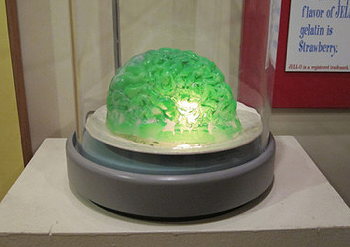
image source: Donna Goldstein, researchgate.net
More info: The Straight Dope

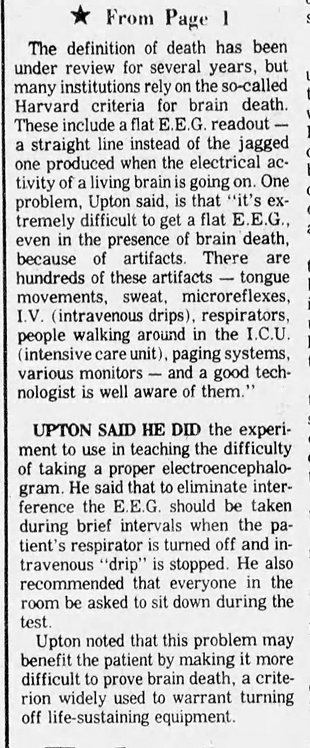
Wichita Eagle - Mar 8, 1976
Posted By: Alex - Mon Nov 15, 2021 -
Comments (7)
Category: Food, Jello, Experiments, 1970s, Brain

| Who We Are |
|---|
| Alex Boese Alex is the creator and curator of the Museum of Hoaxes. He's also the author of various weird, non-fiction, science-themed books such as Elephants on Acid and Psychedelic Apes. Paul Di Filippo Paul has been paid to put weird ideas into fictional form for over thirty years, in his career as a noted science fiction writer. He has recently begun blogging on many curious topics with three fellow writers at The Inferior 4+1. Contact Us |




